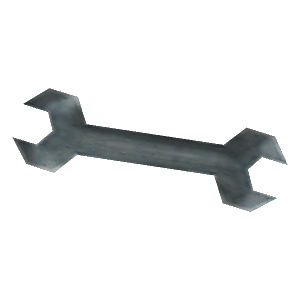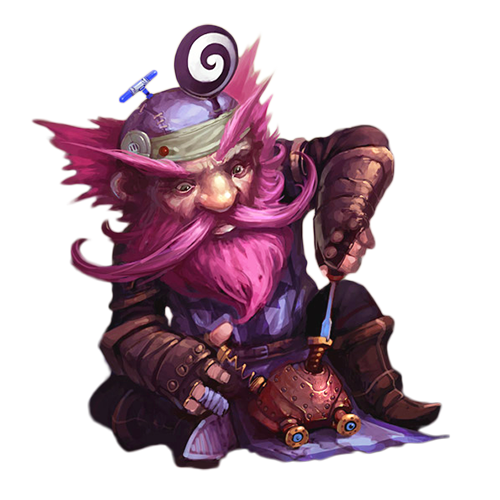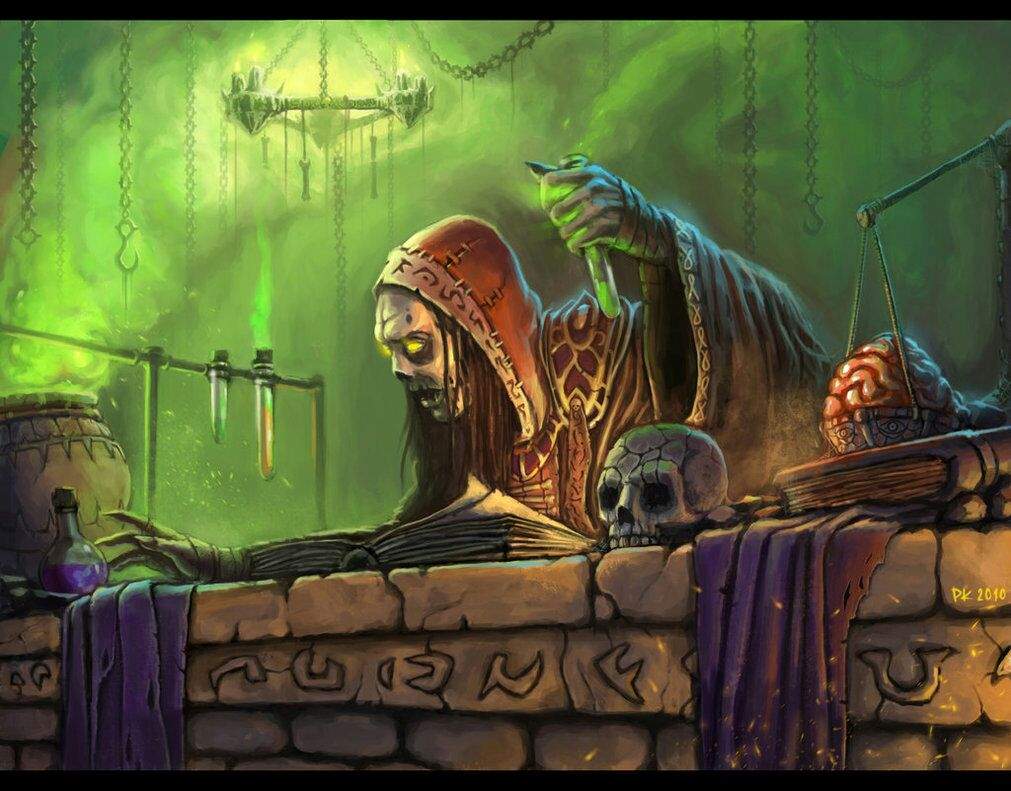Tinker
It is my job to ensure that the power of invention continues to shine brightest from our arclight spanners than anywhere else! Also, if you happen to know a good schematic for radiation elimination, we just so happen to be in the market for one right about now...
— Tinkmaster Overspark
A gnome sits hunched over a workbench, carefully putting the finishing touches on a metallic gun, barely larger than the gnome's hand. With a few twist of the dials on this device, the gnome points it at his sheep, and an arc of blue energy reducing his fluffy friend to the size of a rat. The gnome beams with pride at his newly created shrink ray.
A gnoll growls in hunger as it looms over a dwarf, who slides a long, metal tube from a holster at his belt. With a thunderous roar, a gout of flame erupts from the tube, and the gnoll’s growls turn into shrieks of panic as it turns to flee.
A party of night elves walk around in a large lumber yard, hoping to remove these transgressors from their lands. Suddenly, with a revving of a large engine, a humanoid machine comes to life, one of its arms mounted with a large saw blade. Over the sound of the engine, the elves hear the mad cackling of a goblin, excited at the prospect to test his new toy out on live specimens.
A withered forsaken stands within their laboratory, beakers and cauldrons bubble and spew horrid vapors into the air. The undead cackles and smirks as they uncork a vial from one of their pouches and pour the oozing, crimson liquid into the crucible.
Makers of advanced and seemingly magical technology, tinkers are defined by their inventive nature. The creators of incredible inventions, from crazy multipurpose knives to steam saws to siege engines, their devices allow them to overcome nearly any situation — and if they don't have the device they need, they just might be able to design and create a new one on the spot.
Cunning Inventors
Every tinker is defined by a specific craft, and see mastering the basic methods of their chosen craft as the first step to true progress, the invention of new methods and approaches.
All tinkers are united by their curiosity and inventive nature. To a tinker, inventing is an evolving art with a leading edge of discovery and mastery that pushes further ahead with each passing year. Tinkers value ingenuity and discovery. This penchant pushes them to seek a life of adventure, to not only discover new ways to improve their own inventions, but to find "willing" participants to test them out.
Intense Rivalries
The tinkers’ drive to invent and expand their understanding results in them constantly trying new ideas, and absorbing all the knowledge they can. A tinker who hears news of a newly discovered piece of technology or a new innovation must act fast to get it before any rivals do. While most tinkers are open with information to help advance the craft, all still possess their own trade secrets, and only wish to expand them faster than anyone else.
Almost every tinker has at least one rival, someone whom they seek to outdo at every turn. However, no rivalry out there compares to that that lies between those of the goblin and gnome races, who consistently compete to create an invention that's more innovative, insane, and functional than the last. These competitions are friendly or deadly , depending on the individuals involved - sometimes both.
By the same token, tinkers with similar philosophies and theories band together into loose guilds. They share their discoveries and work together to verify their theories and keep ahead of their rivals. One of the most prominent tinkers' guilds out there is the goblin run Tinkers' Union: avid explosions, laughter, and innovation prevade the halls of this union.



The Tinker
| Level | Proficiency Bonus | Cobble Die | Features | Schematics Known |
|---|---|---|---|---|
| 1st | +2 | 1d4 | Cobble, Gadgetry | 2 |
| 2nd | +2 | 1d4 | Tinker Specialization | 2 |
| 3rd | +2 | 1d4 | Engineering Style, The Right Tool for the Job | 2 |
| 4th | +2 | 1d4 | Ability Score Improvement | 3 |
| 5th | +3 | 1d6 | Extra Attack | 3 |
| 6th | +3 | 1d6 | Specialization Feature, Tool Expertise | 3 |
| 7th | +3 | 1d6 | Scavenger | 4 |
| 8th | +3 | 1d6 | Ability Score Improvement | 4 |
| 9th | +4 | 1d8 | Improved Cobble | 5 |
| 10th | +4 | 1d8 | Specialization Feature | 5 |
| 11th | +4 | 1d8 | Additional Engineering Style | 5 |
| 12th | +4 | 1d8 | Ability Score Improvement | 6 |
| 13th | +5 | 1d10 | ─ | 6 |
| 14th | +5 | 1d10 | Specialization Feature | 6 |
| 15th | +5 | 1d10 | Arcane Understanding | 7 |
| 16th | +5 | 1d10 | Ability Score Improvement | 7 |
| 17th | +6 | 1d12 | Improvisation | 7 |
| 18th | +6 | 1d12 | Additional Engineering Style | 8 |
| 19th | +6 | 1d12 | Ability Score Increase | 8 |
| 20th | +6 | 1d12 | Magnum Opus | 8 |
Hit Points
- Hit Dice: 1d8 per Tinker level
- Hit Points at 1st Level: 8 + your Constitution modifier
- Hit Points per Level after 1st: 1d8 (or 5) + your Constitution modifier
Proficiencies
- Saving Throws: Constitution, Intelligence
- Skills: Choose two from Arcana, History, Investigation, Medicine, Nature, Perception, Sleight of Hand
- Armor: Light armor, medium armor
- Weapons: Simple weapons, firearms, crossbows
- Tools: Thieves' Tools, Tinker's Tools, one type of artisan's tools of your choice
Equipment
You start with the following equipment, in addition to the equipment granted by your background:
- any two simple weapons
- a pistol and 20 bullets
- (a) a studded leather armor or (b) chain shirt
- tinker's tools and a dungeoneer's pack
Optional Rule: Multiclassing
If your group uses the optional rule on multiclassing in the Player's Handbook, here's what you need to know if you choose tinker as one of your classes.
Ability Score Minimum. As a multiclass character, you must have at least an Intelligence score of 13 to take a level in this class, or to take a level in another class if you are already a tinker.
Proficiencies Gained. If tinker isn't your initial class, here are the proficiencies you gain when you take your first level as a tinker: light armor, medium armor, firearms, thieves’ tools, tinker’s tools.
Class Features
As a Tinker, you gain the following class features when you reach the specified levels in this class. These features are listed on The Tinker table.

Cobble
Starting at 1st level, your skill as a tinker helps you to make quick repairs and even improvements while on the road. You know the mending cantrip, and can use your tinker's tools as a spellcasting focus for it.
Additionally, your quick thinking and innovative spirit allows you to quickly cobble together a solution to any problem you face, represented by your Cobble die, which is a d4.
Using Cobble Die. You can use your Cobble die in the following ways:
- When a creature within 30 feet of you that you can see makes an attack roll, you can use your reaction to roll your Cobble die and add the number rolled to the attack roll.
- When an attack roll is made against a creature within 30 feet of you that you can see, you can use your reaction to roll your Cobble die and add half the number rolled to the creature's AC until the start of its next turn.
- When a creature within 30 feet of you makes an ability check, you can use your reaction to roll your Cobble die and add the number rolled to the ability check.
Number of Uses. A Cobble die is expended when it is rolled. You can use a Cobble die a number of times equal to your Proficiency Bonus. You regain any expended uses when you finish a long rest.
At Higher Levels. Your Cobble die changes when you reach certain levels in this Class, as shown in the Cobble Die column of The Tinker table. The die becomes a d6 at 5th level, a d8 at 9th level, a d10 at 13th level, and a d12 at 17th level.
Gadgetry
Also at 1st level, you have devised Schematics, ingenious or novel designs for contraptions with a range of effects.
Schematics Known
You gain two schematics of your choice, choosing from the "Gadgetry Schematics" section at the end of the class's description. You learn additional schematics of your choice when you reach certain levels in this class, as shown in the Schematics Known column of the Tinker class table. You must meet all of a schematic's prerequisites to learn it.
Whenever you gain a level in this class, you can replace one of the gadgetry schematics you learned with a new one.
Gadgetry Ability
Because your schematics rely on your tinkering and innovation, you use your Intelligence whenever a schematic refers to your gadgetry ability. In addition, you use your Intelligence modifier when setting the saving throw DC for a schematic and when making an attack roll with one.
Gadgetry save DC = 8 + your proficiency bonus +
your Intelligence modifier
Gadgetry attack modifier = your proficiency bonus +
your Intelligence modifier
Using Schematics
With artisan's tools in hand, you can create a gadget described in one of your schematics in an an unoccupied space within 5 feet of you. This creation requires 1 hour of uninterrupted work, which can coincide with a short or long rest. These gadgets are nonmagical and remain until destroyed, but can only be used by you.
You can only use a schematic to create one gadget at a time. If you try to create a second gadget using the same schematic, the first is immediately destroyed. A gadget is also destroyed if you replace the schematic used to create it with new schematic.
Tinker Specialization
At 2nd level, you specialize in a specific kind of tinkering. Your choice grants you features at 1st level and again at 6th, 10th, and 14th level.
Engineering Style
Beginning at 3rd level, you have developed a style of tinkering, that roughly aligns with the design philosophies of a certain race known for their innovation. Choosing between the following Engineering Styles, you learn new ways to use your Cobble die.
Draenei Engineering. Immediately after a creature within 30 feet of you that you can see takes damage, you can use your reaction to roll your Cobble die and restore a number of hit points equal to the number rolled.
Dwarven Engineering. When you use your Cobble die to increase a creature's AC, the creature gains temporary hit points equal to the number rolled on the Cobble die.
Forsaken Engineering. When a creature within 30 feet of you that can see forces another creature to make a saving throw, you can use your reaction to roll your Cobble die and add half the number rolled to the saving throw DC.
Gnomish Engineering. When you use your Cobble die to increase a creature's ability check, you can roll the Cobble die again and choose which roll to use.
Goblin Engineering. When you use your Cobble die to increase a creature's attack roll against a target, the target and each creature of your choice that you can see within 5 feet of it must succeed on a Dexterity saving throw against your spell save DC or take fire damage equal to the number rolled on the Cobble die.
Sin'dorei Engineering. When a creature within 30 feet of you that you can seee is forced to make a saving throw against a spell, you can use your reaction to roll your Cobble die and add the number rolled to the saving throw.
The Right Tool for the Job
Also at 3rd level, you've learned how to produce exactly the tool you need: with artisan's tools in hand, you can create one set of artisan's tools in an unoccupied space within 5 feet of you. This creation requires 1 hour of uninterrupted work, which can coincide with a short or long rest. The tools are nonmagical, and they are disassembled when you use this feature again.
Ability Score Improvement
When you reach 4th level, and again at 8th, 12th, 16th, and 19th level, you can increase one ability score of your choice by 2, or you can increase two ability scores of your choice by 1. As normal, you can't increase an ability score above 20 using this feature.
Extra Attack
Beginning at 5th level, you can attack twice, instead of once, whenever you take the Attack action on your turn.
Tool Expertise
At 6th level, your proficiency bonus is now doubled for any ability check you make that uses your proficiency with a tool.
Scavenger
Starting at 7th level, you regain all your expended uses of Cobble when you finish a short or long rest.
Improved Cobble
When you reach 9th level, you achieve an advanced understanding of slapdash engineering. Your Cobble die can be used on creatures within 60 feet. Additionally, you gain additional ways to use your Cobble feature:
- You can touch a gadget or magical item with a limited number of uses and expend a Cobble die to restore one use.
- You can touch a gadget or magical item with a limited number of charges and roll a Cobble die to restore a number of charges equal to half the number rolled.
- You can touch a vehicle or object with hit points and roll a Cobble die to add double the number rolled as temporary hit points for the object.
Arcane Understanding
At 15th level, your discoveries in the field of magical science allow you to attune with up to 4 magical items at once.
Additonally, you ignore all class, race, spell and level requirements on attuning to or using a magic item.
Improvisation
At 17th level, when you roll initiative and have no uses of Cobble left, you regain one use.
Additionally, as an action, you can choose one of the schematics you know and replace it with another schematic that you could learn at that level.
You can use this feature twice, and regain expended uses when you finish a long rest.
Magnum Opus
At 20th level, you have achieved a mastery of tinkering, and can devise a marvel of engineering; your masterpiece.
Creating your masterpiece may take weeks, months, or even years depending on the scope of the project. Work with your DM to figure out the logistics of gold cost and time spent. Examples of masterpieces may be High Tinker Mekkatorque's efficient Deeprun Tram, Orgrimmar's design by Chief Engineer (and future Trade Prince) Gazlowe, or Grand Apothecary Putress' devastating Blight.





Tinker Specializations
Apothecary Specialization
Apothecaries are masters of alchemy and use herbs to create strange, magical brews that heal, harm, and produce a variety of positive or negative effects. While common apothecaries are forsaken, who established the Royal Apothecary Society, many goblins, humans, blood elves, and even pandaren claim such a title.
Potion Brewer
Mixologist
Adept Concoctions
Alchemical Mastermind
Sapper Specialization
Artillerists, sappers, demolitionists, grenadiers, all similar names to describe the same thing: experts in the handling of explosive weapons. The mischievous goblin sappers are known throughout the Horde for their incredible aptitude for destruction, and dwarven mortar teams proved invaluable to the Alliance in every battle they've appeared.
Sappers are masters of one thing, explosions! They use this specialty to carve ruin into enemy ranks and level fortifications.
Explosives For Dummies
When you choose this specialization at 1st level, your affinity for destruction results in your discovery of explosive munitions. Whenever you finish a long rest, you can produce a number of explosive munitions equal to your Proficiency Bonus. When you do this, you choose between creating an Impact Grenade or Pressure Mine, with the effects for each listed below.
- Impact Grenades. As a bonus action, you can throw a grenade (to a point within 30 feet) or hurl it with a sling (to a point within the sling's long range). It detonates on impact, and each creature within a 10-foot radius must make a Dexterity saving throw against your Gadgetry save DC. On a failed save, affected creatures take 2d6 fire damage on a failed save and are pushed 10 feet from the center of the explosion. Creatures that succeed take half as much damage and aren't pushed.
- Pressure Mine. As a bonus action, you can set up a mine to cover a level, square area that is 10 feet on a side. There must not be a creature within the targeted area when you set up the mine. When a creature moves across the covered area, the mine detonates forcing all creatures within 5 feet of the covered area to make a Dexterity saving throw against your Gadgetry save DC. On a failed save, affected creatures take 2d8 fire damage and are knocked prone. Creatures that succeed take half as much damage and aren't knocked prone.
Creating an explosive munition in this way requires you to have tinker's tools or gunsmith's tools on your person, and any explosive munition you create with this feature lasts until it explodes or until the end of your next long rest.
When you reach certain levels in this class, your explosive munitions' damage increases by one dice when you reach 6th level (3d6 and 3d8, repsectively), 10th level (4d6 and 4d8), and 14th level (5d6 and 5d8). Each explosive munition you produce can be of a different type.
Battlefield Demolition
At 6th level, you are a scholar in explosive theory. Your bombs deal twice as much damage to objects and structures and you have resistance to damage dealt by your own bombs.
In addition, you can put together improvised explosives quickly. As an action, you can expend a Cobble die to produce an explosive munition, as detailed in your Explosives For Dummies feature.
Doctorate In Destruction
Starting at 10th level, you've mastered the perfect time it takes to prime an explosive. As an action, you can cause your next explosive munition to explode unexpectedly, giving all affected creatures disadvantage on their saving throw. You can use this action only if you haven't moved during this turn, and after you use the action, your speed is 0 until the end of the current turn.
You can use this feature twice, and recover expended uses at the end of a long rest.
Master Blaster
At 14th level, you have achieved a mastery of the explosive arts. Magical barriers that can be destroyed by the Disintegrate spell (like Wall of Force, Otiluke Resilient Sphere, etc.) are also destroyed when they should take damage from one of your explosive munitions.
Additionally, When one of your explosive munitions are triggered, you can choose it to be The Big One, causing it to deal an extra 5d6 thunder damage. Once you use either feature, you can't use it again until you finish a long rest.
Gadgeteer Specialization
Gadgeteers are tinkers that combine the benefits from both magic and technology to create wondrous magical devices. Most gadgeteers are gnomes, blood elves, and draeneis, with gnomish gadgeteers establishing the Enlightened Assembly of Arcanology, Alchemy and Engineering Sciences.
Prepared with all forms of gadgets and devices to help in any situation, the gadgeteer is often seen as the quintessentiai tinker.
Spellcasting
When you choose this specialization at 1st level, you augment your martial prowess with the ability to cast spells.
Cantrips. You learn two cantrips of your choice from the mage spell list. You learn an additional wizard cantrip of your choice at 4th level and another at 10th level.
Spell Slots. The Gadgeteer Spellcasting table shows how many spell slots you have to cast your spells of 1st level and higher. To cast one of these spells, you must expend a slot of the spell's level or higher. You regain all expended spell slots when you finish a long rest.
For example, if you know the 1st-level spell shield and have a 1st-level and a 2nd-level spell slot available, you can cast shield using either slot.
Spells Known of 1st Level and Higher. You know three 1st-level mage spells of your choice.
The Spells Known column of the Gadgeteer Spellcasting table shows when you learn more mage spells of 1st level or higher. Each of these spells must be of a level for which you have spell slots. For instance, when you reach 7th level in this class, you can learn one new spell of 1st or 2nd level.
Whenever you gain a level in this class, you can replace one of the mage spells you know with another spell of your choice from the mage spell list. The new spell must be of a level for which you have spell slots.
Spellcasting Ability. Intelligence is your spellcasting ability for your mage spells, since you learn your spells through tinkering and experimentation. You use your Intelligence whenever a spell refers to your spellcasting ability. In addition, you use the same method for determining your schematics' saving throw DC and when making an attack roll, as detailed in the "Gadgetry" feature, for when you cast a mage spell that requires a saving throw or attack roll.
Spellcasting Focus. You can use a set of tinker's tools as a spellcasting focus for your mage spells.
Magical Augmentation
Also at 1st level, you learn how to augment your spells, pushing them to their limits. Whenever you cast a spell, expend a number of Cobble die to apply one of the following Augmentations to the spell.
You can use only one Augmentation option on a spell when you cast it, unless otherwise noted.
Elementium Converter. When you cast a spell that deals a type of damage from the following list, you can expend 1 Cobble die to change that damage type to one of the other listed types: acid, cold, fire, lightning, poison, thunder.
Heat Seeking. When you cast a spell and make an attack roll as a part of that spell, or force a creature to make a saving throw, you can expend 1 Cobble die to gain advantage on the attack roll or impose disadvantage on the saving throw respectively.
Hyperspeed Accelerator. When you cast a spell with a casting time of one action, you can expend 2 Cobble dice to change the casting time to 1 bonus action for this casting.
Railgun Cannon. When you cast a spell that has a range of 5 feet or greater, you can expend 1 Cobble die to double the range for the spell.
When you cast a spell that has a range of touch, you can expend 1 Cobble die to make the range of the spell 30 feet.
Selective Targeting. When you cast a spell that forces another creature to make a saving throw, you can protect some from the spell's full force. To do so, you can expend 1 Cobble die and choose a number of those creatures up to your Intelligence modifier (minimum of one creature). A chosen creature automatically succeeds on its saving throw against the spell.
Gadgeteer Spellcasting
| Tinker Level |
Cantrips Known |
Spells Known |
1st | 2nd | 3rd | 4th |
|---|---|---|---|---|---|---|
| 1st | 2 | 3 | 2 | ─ | ─ | ─ |
| 2nd | 2 | 3 | 2 | ─ | ─ | ─ |
| 3rd | 2 | 3 | 2 | ─ | ─ | ─ |
| 4th | 3 | 4 | 3 | ─ | ─ | ─ |
| 5th | 3 | 4 | 3 | ─ | ─ | ─ |
| 6th | 3 | 4 | 3 | ─ | ─ | ─ |
| 7th | 3 | 5 | 4 | 2 | ─ | ─ |
| 8th | 3 | 6 | 4 | 2 | ─ | ─ |
| 9th | 3 | 6 | 4 | 2 | ─ | ─ |
| 10th | 4 | 7 | 4 | 3 | ─ | ─ |
| 11th | 4 | 8 | 4 | 3 | ─ | ─ |
| 12th | 4 | 8 | 4 | 3 | ─ | ─ |
| 13th | 4 | 9 | 4 | 3 | 2 | ─ |
| 14th | 4 | 10 | 4 | 3 | 2 | ─ |
| 15th | 4 | 10 | 4 | 3 | 2 | ─ |
| 16th | 4 | 11 | 4 | 3 | 3 | ─ |
| 17th | 4 | 11 | 4 | 3 | 3 | ─ |
| 18th | 4 | 11 | 4 | 3 | 3 | ─ |
| 19th | 4 | 12 | 4 | 3 | 3 | 1 |
| 20th | 4 | 13 | 4 | 3 | 3 | 1 |
Magical Malfunctions
Due to the experimental nature of your magical technology, there is always a chance for it to go awry. Whenever you augment a spell using your Magical Augmentation feature, roll a d20. If you roll a 1, a malfunction occurs depending on the kind of magical augmentation you used in addition to the regular augmentation effect.
If a malfunction doesn't occur, the chances of it happening are higher. Every time time you succeed on a Magical Malfunction roll, the number needed to be rolled for a malfunction to occur increases by 1 until a malfunction occurs or until you finish a long rest.
Elementium Converter Malfunction. The volatile elementium discharges the unaltered elemental energy at you. You take an amount of damage, of the same type the augmented spell originally dealt, equal to one roll of your Cobble die.
Heat Seeking Malfunction. The targeting mainframe becomes misaligned. Roll a dice with a number of sides equal to the number of creatures within 30 feet of the target, assigning a value to each creature. If you roll the number assigned to a creature, the spell targets them instead of your original target.
Hyperspeed Accelerator Malfunction. Time temporarily warps in a reverse direction. You are under the effects of a slow spell until the end of your next turn.
Railgun Cannon Malfunction. The electromagnetic stabilizer overcharges. You are pushed 30 feet away from your target.
Selective Targeting Malfunction. The spell becomes weakened but widespread through the alteration of arcane energy. All creature in the targeted area, including the creatures chosen to succeed, instead must make their saves with advantage.
Magical Superfunctions
At 6th level, your inventions have developed to the point that they sometimes work better than intended. Whenever you make a Magical Malfunction roll, and you roll a 20, a superfunction occurs and the augmented spell is cast one spell level higher than the spell slot you used to cast it with.
Safety First
At 10th level, you've trained yourself in additional safety precautions. Whenever make a Magical Malfunction roll, you can roll twice and use either number.
Mechano-Mage
At 14th level, you've become a master in blending your magical and technological prowess. You gain the following effects:
- You can cast the transport via plants spell once, targeting two machines on the same plane of existence instead of two plants. You must finish a long rest before you can cast it again with this feature.
- Whenever you fail a concentration saving throw, you can choose to expend a Cobble die to temporarily disable one of your Gadgetry schematics, until the end of your long rest, but turn the failed save into a successful one. You must finish a long rest before you can activate this effect again.

